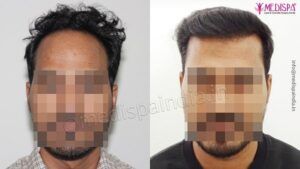
Hair loss treatment through hair transplant has gained immense popularity in India, with a high demand for the procedure across the nation. Not only do local patients opt to travel to India for the best and most cost-effective hair transplant, but foreign patients also choose India as their destination. The cost of hair transplant in India is significantly lower compared to Western countries, making it an attractive option for patients worldwide seeking hair transplant tourism.
Since 2005, the Medispa hair transplant clinic has established itself as one of the leading clinics in the country, renowned for delivering quality and consistently successful hair transplant results. We cater to patients from diverse backgrounds, including different races, ethnicities, hair types, and skin tones. With over 18 years of experience, we have successfully completed more than 10,000 hair transplant procedures, showcasing our extensive expertise in handling a wide range of hair transplant cases.
Dr. Suneet Soni, a renowned and one of the best hair transplant surgeon in India, is highly regarded for his exceptional surgical skills and keen eye for aesthetics. Numerous patients, including celebrities, have lauded his work, establishing him as the preferred choice for renowned personalities.
The basics of hair transplant
Hair transplant procedures involve several important steps. First, a thorough planning phase is conducted to select the donor location, assess the required number of hair follicles, determine the appropriate technique, and estimate the cost of the procedure. During the surgery, carefully hand-selected hair follicles from the donor area are transplanted to the desired bald area. It is crucial to consider the area with permanent hair roots when choosing the donor location. Overharvesting the donor region should be avoided as it can compromise the safe zones, deplete the donor area, and negatively affect the long-term viability of the outcomes.
Techniques to perform hair transplant
The most commonly used techniques for hair transplantation are FUT and FUE. FUT, also known as the strip method, involves removing a thin strip of hair from the donor area, dissecting it to obtain individual hair follicles, suturing the donor site, and then transplanting the follicles to the recipient site. With the FUT procedure, we were able to extract approximately 3000-3500 hair follicles. On the other hand, FUE involves using a punch motorized device to extract hair follicles one by one from the skin. Each follicle is carefully retrieved in the direction of hair growth. These follicles are then replanted in the desired bald area. Through the FUE procedure, we were able to collect around 2000-2500 hair grafts.
Advanced techniques for hair transplant
There are only a handful of hair transplant clinics in India that have adopted advanced hair transplant procedures and consistently perform them, leading to exceptional outcomes. Medispa Hair Transplant Clinic stands out among these select clinics in India, renowned for delivering top-notch hair transplant results using modern techniques. The advancements in hair transplant procedures primarily aim to achieve the utmost hair density while ensuring a completely natural look. Here are a few of the cutting-edge hair transplant techniques available:
- The FUT/FUE combination technique was developed to provide ample coverage to the bald area in advanced cases in just one session or to achieve high density hair transplantation. The majority of hair grafts are obtained through the FUT procedure, while the rest are extracted using the FUE hair transplant technique. This method enables the harvesting of more than 4000 hair grafts and allows for additional sessions if there is further hair loss in the future.
- BHT, also known as body hair transplant, involves extracting hair grafts from areas of the body other than the scalp and transplanting them to the desired bald area. This technique is combined with FUT and FUE to enhance the success rate of hair transplants and address severe baldness in a single session. By collecting hair grafts from different parts of the body, BHT minimizes the risk of damage during the FUE hair transplant procedure. A 0.75 mm punch surgical instrument is used to extract the hair grafts from beneath the chin, resulting in minimal scarring that is hardly noticeable.
Hair transplant: After effects
The hair transplant procedure is a minimally invasive treatment that has minimal short-term complications and does not result in any morbidity. Patients can easily resume their regular activities the day after the procedure. However, there are potential complications that may arise following a hair transplant:
- 1. Swelling: Swelling is a common complication that typically lasts for 5-7 days after the procedure. It primarily affects the forehead but can occasionally extend to the eyelids. To alleviate swelling, patients are advised to sleep with their head elevated at a 45° angle. Additionally, wearing recommended headbands for 4 hours a day for 2 days can also aid in reducing swelling.
- Itchiness: Itchiness is a common issue that can be easily managed and usually goes away within a week. Following regular washing and using the lotions prescribed by your hair transplant surgeon can help control the itchiness.
- Numbness: Some patients may experience numbness for a few weeks after the hair transplant procedure, but it usually resolves on its own. However, if the numbness persists, it is important to seek further examination from your hair transplant surgeon.
- Discomfort: Mild discomfort is normal after a hair transplant procedure and can usually be managed without medication. However, if the discomfort becomes unbearable, it is advisable to consult your hair transplant surgeon before attempting any self-treatment for pain relief.
- Scalp imperfections: These imperfections might manifest a couple of weeks after receiving a hair transplant, initially appearing as a potential complication. Nevertheless, they are indeed a promising sign of hair growth. As these imperfections rupture, the hair strands may shed, but this is succeeded by the emergence of fresh hair strands from the transplanted hair follicles. These newly grown hair strands become noticeable approximately three months after the completion of the hair transplant procedure.






